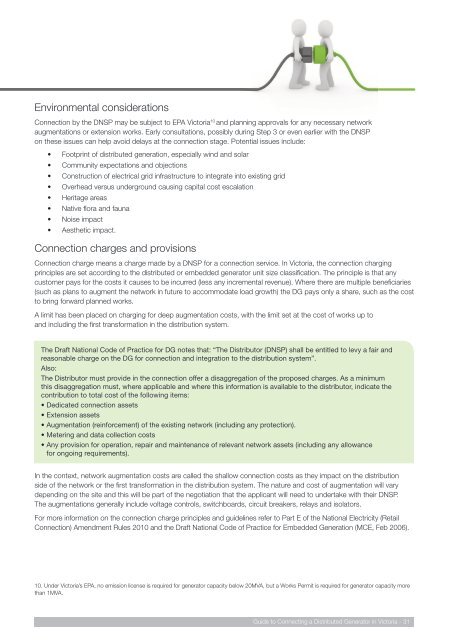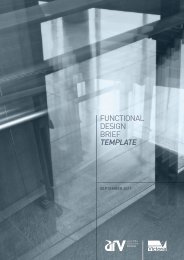Guide to Connecting a Distributed Generator - Sustainability Victoria
Guide to Connecting a Distributed Generator - Sustainability Victoria
Guide to Connecting a Distributed Generator - Sustainability Victoria
You also want an ePaper? Increase the reach of your titles
YUMPU automatically turns print PDFs into web optimized ePapers that Google loves.
Environmental considerationsConnection by the DNSP may be subject <strong>to</strong> EPA Vic<strong>to</strong>ria 10 and planning approvals for any necessary networkaugmentations or extension works. Early consultations, possibly during Step 3 or even earlier with the DNSPon these issues can help avoid delays at the connection stage. Potential issues include:• Footprint of distributed generation, especially wind and solar• Community expectations and objections• Construction of electrical grid infrastructure <strong>to</strong> integrate in<strong>to</strong> existing grid• Overhead versus underground causing capital cost escalation• Heritage areas• Native flora and fauna• Noise impact• Aesthetic impact.Connection charges and provisionsConnection charge means a charge made by a DNSP for a connection service. In Vic<strong>to</strong>ria, the connection chargingprinciples are set according <strong>to</strong> the distributed or embedded genera<strong>to</strong>r unit size classification. The principle is that anycus<strong>to</strong>mer pays for the costs it causes <strong>to</strong> be incurred (less any incremental revenue). Where there are multiple beneficiaries(such as plans <strong>to</strong> augment the network in future <strong>to</strong> accommodate load growth) the DG pays only a share, such as the cost<strong>to</strong> bring forward planned works.A limit has been placed on charging for deep augmentation costs, with the limit set at the cost of works up <strong>to</strong>and including the first transformation in the distribution system.The Draft National Code of Practice for DG notes that: “The Distribu<strong>to</strong>r (DNSP) shall be entitled <strong>to</strong> levy a fair andreasonable charge on the DG for connection and integration <strong>to</strong> the distribution system”.Also:The Distribu<strong>to</strong>r must provide in the connection offer a disaggregation of the proposed charges. As a minimumthis disaggregation must, where applicable and where this information is available <strong>to</strong> the distribu<strong>to</strong>r, indicate thecontribution <strong>to</strong> <strong>to</strong>tal cost of the following items:• Dedicated connection assets• Extension assets• Augmentation (reinforcement) of the existing network (including any protection).• Metering and data collection costs• Any provision for operation, repair and maintenance of relevant network assets (including any allowancefor ongoing requirements).In the context, network augmentation costs are called the shallow connection costs as they impact on the distributionside of the network or the first transformation in the distribution system. The nature and cost of augmentation will varydepending on the site and this will be part of the negotiation that the applicant will need <strong>to</strong> undertake with their DNSP.The augmentations generally include voltage controls, switchboards, circuit breakers, relays and isola<strong>to</strong>rs.For more information on the connection charge principles and guidelines refer <strong>to</strong> Part E of the National Electricity (RetailConnection) Amendment Rules 2010 and the Draft National Code of Practice for Embedded Generation (MCE, Feb 2006).10. Under Vic<strong>to</strong>ria’s EPA, no emission license is required for genera<strong>to</strong>r capacity below 20MVA, but a Works Permit is required for genera<strong>to</strong>r capacity morethan 1MVA.<strong>Guide</strong> <strong>to</strong> <strong>Connecting</strong> a <strong>Distributed</strong> Genera<strong>to</strong>r in Vic<strong>to</strong>ria - 31




